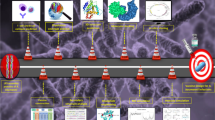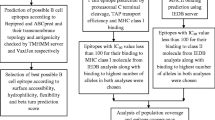Abstract
The present study is aimed to identify potent vaccine peptide candidates against bapAB protein in A.baumannii involved with the biofilm associated virulence using immune informatics approach. FASTA sequence of the bapAB protein from A.baumannii was subjected to assess druggability, physico-chemical analysis, IEDB T-cell mapping, class-1 immunogenicity, conservancy and toxigenicity evaluations together with class-II epitope predictions. Final selection of B-cell epitopes was done with IEDB B-cell epitope tool and final docking of the peptides were interpreted by hydrogen bonds and interaction scores with TLR-2. Promising scores on antigenicity, GRAVY, instability and aliphatic index were obtained. Based on the combinatorial scores, 9 peptides (20aa) were selected on the positive scores of class-I immunogenicity and 7 peptides possessed > 50% class-I conservancy. Class-II conservancy yielded 5 epitopes (E1-E5) with > 50% conservancy with final predictions as non-toxic, probable, soluble and stable antigens for vaccine design. Galaxy WEBDock with TLR-2 receptor showed promising interactions for all epitopes with E2 and E3 possessing a maximum hydrogen bond interactions (n = 13) followed by E1.



Similar content being viewed by others
References
Brossard KA, Campagnari AA (2012) The Acinetobacter baumannii biofilm-associated protein plays a role in adherence to human epithelial cells. Infect Immun 80:228–233
Havenga B, Ndlovu T, Clements T, Reyneke B, Waso M, Khan W (2019) Exploring the antimicrobial resistance profiles of WHO critical priority list bacterial strains. BMC Microbiol 19:303
Choi AH, Slamti L, Avci FY, Pier GB, Maira-Litran T (2009) The pgaABCD locus of Acinetobacter baumannii encodes the production of poly-_-1-6-N-acetylglucosamine, which is critical for biofilm formation. J Bacteriol 191:5953–5963
Chou PY, Fasman GD (1978) Prediction of the secondary structure of proteins from their amino acid sequence. Adv. in enzymol. And Related areas of Mol Biol 47:45–148
Christensen H, Hickman M, Edmunds WJ, Trotter CL (2013) Introducing vaccination against serogroup B meningococcal disease: an economic and mathematical modelling study of potential impact. Vaccine 31:2638–2646
De Silva PM, Kumar A (2019) Signal Transduction Proteins in Acinetobacter baumannii: Role in Antibiotic Resistance, Virulence, and Potential as Drug Targets. Front Microbiol 10:49
Dijkshoorn L, van der Toorn J (1992) Acinetobacter species: which do we mean? Clin Infect Dis 15:748–749
Doytchinova IA, Flower DR (2007) VaxiJen: a server for prediction of protective antigens, tumour antigens and subunit vaccines. BMC Bioinformatics 8:4
Gaddy JA, Tomaras AP, Actis LA (2009) The Acinetobacter baumannii 19606 OmpA protein plays a role in biofilm formation on abiotic surfaces and in the interaction of this pathogen with eukaryotic cells. Infect Immun 77:3150–3160
Garnacho J, Sole-Violan J, Sa-Borges M, Diaz E, Rello J (2003) Clinical impact of pneumonia caused by Acinetobacter baumannii in intubated patients: a matched cohort study. Crit Care Med 31(10):2478–2482
Gasteiger E, Hoogland C, Gattiker A (2005) Protein identification and analysis tools on the ExPASy server. In: Walker JM (ed) The Proteomics Protocols Handbook. Humana Press, New York, NY, pp 571–607
Hall-Stoodley L, Costerton JW, Stoodley P (2004) Bacterial biofilms: from the natural environment to infectious diseases. Nat Rev Microbiol 2:95–108
Hinsa SM, Espinosa-Urgel M, Ramos JL, O’Toole GA (2003) Transition from reversible to irreversible attachment during biofilm formation by Pseudomonas fluorescens WCS365 requires an ABC transporter and a large secreted protein. Mol Microbiol 49:905–918
Karplus PA, Schulz GE (1985) Prediction of chain flexibility in proteins. Naturwissenschaften 72:212–213
Knox C et al (2011) DrugBank 3.0: a comprehensive resource for ‘omics’ research on drugs. Nucleic Acids Res 39:D1035–1041
Kolaskar AS, Tongaonkar PC (1990) A semi-empirical method for prediction of antigenic determinants on protein antigens. FEBS Lett 276:172–174
Larsen JEP, Lund O, Nielsen M (2006) Improved method for predicting linear B-cell epitopes. Immun Res 2:2
Larsen MV et al (2007) Large-scale validation of methods for cytotoxic T-lymphocyte epitope prediction. BMC Bioinformatics 8:424
Latasa C, Solano C, Penades JR, Lasa I (2006) Biofilm-associated proteins. C R Biol 329:849–857
Loehfelm TW, Luke NR, Campagnari AA (2008) Identification and characterization of an Acinetobacter baumannii biofilm-associated protein. J Bacteriol 190:1036–1044
Magnan CN, Zeller M, Kayala MA, Vigil A, Randall A, Felgner PL, Baldi P (2010) High-throughput prediction of protein antigenicity using protein microarray data. Bioinformatics 26(23):2936–2943
Maragakis L, Perl TM (2008) Acinetobacter baumannii: epidemiology, antimicrobial resistance, and treatment options. Clin Infect Dis 46:1254–1263
Parker JM, Guo D, Hodges RS (1986) New hydrophilicity scale derived from high-performance liquid chromatography peptide retention data: correlation of predicted surface residues with antigenicity and X-ray-derived accessible sites. Biochemistry 25:5425–5432
Rice LB (2008) Federal funding for the study of antimicrobial resistance in nosocomial pathogens: no ESKAPE. J Infect Dis 197:1079–1081
Smiline Girija AS, Vijayashree Priyadharsini J, Arumugam P (2019a) CLSI based antibiogram profile and the detection of MDR and XDR strains of Acinetobacter baumannii isolated from urine samples. Med J of the Isl Rep of Iran 33(3):11–16
Smiline Girija AS, Vijayashree Priyadharsini J, Arumugam P (2018a) Molecular characterization of plasmid encoded blaTEM, blaSHV and blaCTX-M among extended spectrum β-lactamases [ESBL’s] producing Acinetobacter baumannii. Brit J of Biomed Sci 16(8):1–3
Smiline Girija AS, Vijayashree Priyadharsini J, Arumugam P (2017) Plasmid encoded tet-A and tet-B mediated tetracycline, doxycycline and minocycline resistance among Acinetobacter baumannii isolated from urine samples. Roum Arch of Microbiol and Immunol 76(3–4):134–140
Smiline Girija AS, Vijayashree Priyadharsini J, Arumugam P (2019b) Plasmid encoded dfrA-1, dfrA-5, sul 1 and sul 2 mediated trimethoprim sulfamethoxazole [TMP-SMX] resistance among Acinetobacter baumannii isolated from urine samples of patients with severe UTI. J of Glob Antimicrob Resistance 17:145–146
Smiline Girija AS, Vijayashree Priyadharsini J, Arumugam P (2018b) Prevalence of VIM and GIM producing Acinetobacter baumannii from patients with severe UTI. Acta Microbial et immunol Hungarica 16(8):1–12
Solanki V, Tiwari V (2018) Subtractive proteomics to identify novel drug targets and reverse vaccinology for the development of chimeric vaccine against Acinetobacter baumannii. Sci Rep 8:9044
Thomsen M, Lundegaard C, Buus S, Lund O, Nielsen M (2013) MHCcluster, a method for functional clustering of MHC molecules. Immunogenetics 65:655–665
Tomaras AP, Dorsey CW, Edelmann RE, Actis LA (2003) Attachment to and biofilm formation on abiotic surfaces by Acinetobacter baumannii: involvement of a novel chaperone-usher pili assembly system. Microbiol 149:3473–3484
Yu NY et al (2010) PSORTb 3.0: improved protein subcellular localization prediction with refined localization subcategories and predictive capabilities for all prokaryotes. Bioinformatics 26:1608–1615
Funding
Self-funded study.
Author information
Authors and Affiliations
Corresponding author
Ethics declarations
Conflict of interest
None to declare.
Additional information
Publisher's Note
Springer Nature remains neutral with regard to jurisdictional claims in published maps and institutional affiliations.
Rights and permissions
About this article
Cite this article
Girija, A.S.S., Shoba, G. & Priyadharsini, J.V. Accessing the T-Cell and B-Cell Immuno-Dominant Peptides from A.baumannii Biofilm Associated Protein (bap) as Vaccine Candidates: A Computational Approach. Int J Pept Res Ther 27, 37–45 (2021). https://doi.org/10.1007/s10989-020-10064-0
Accepted:
Published:
Issue Date:
DOI: https://doi.org/10.1007/s10989-020-10064-0




